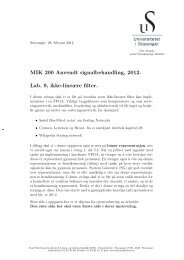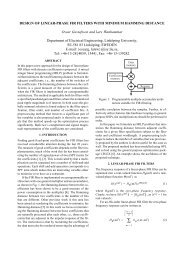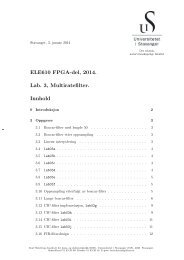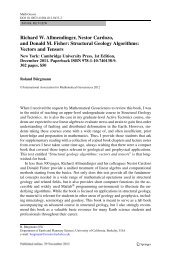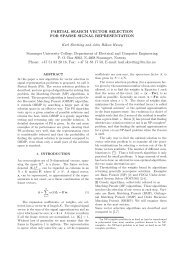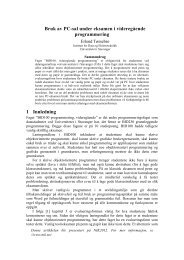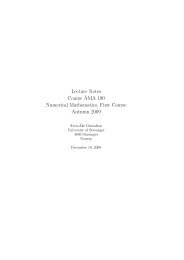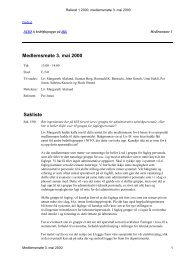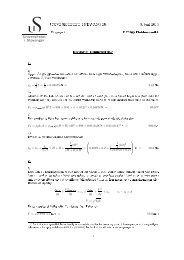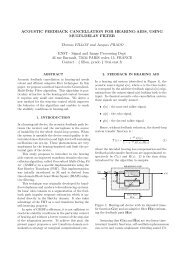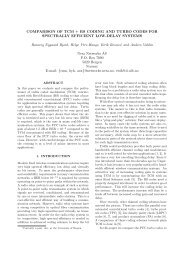MODELING OF LOW SALINITY EFFECTS IN SANDSTONE OIL ...
MODELING OF LOW SALINITY EFFECTS IN SANDSTONE OIL ...
MODELING OF LOW SALINITY EFFECTS IN SANDSTONE OIL ...
You also want an ePaper? Increase the reach of your titles
YUMPU automatically turns print PDFs into web optimized ePapers that Google loves.
8 OMEKEH, EVJE, AND FRIISfor a dynamic change from an initial high salinity state towards a low salinity state controlled bythe degree of desorption of calcium and magnesium from the core.3.3. Modeling of transition from high salinity to low salinity conditions. In this work, wefollow along the lines of [14, 15], and model wettability alteration by defining relative permeabilitycurves through an interpolation between the high salinity and low salinity curves given by (14),combined with the data specified in Appendix B as given by (97) and (98).More precisely, motivated by the proposed hypothesis that transition from a high salinity wettingstate towards low salinity conditions depends on the desorption of calcium and magnesiumcaused by the cation exchange process, the following interpolation is proposed:(19) k(s, β ca , β mg ) = H(β ca , β mg )k HS (s) + [1 − H(β ca , β mg )]k LS (s),where H(β ca , β mg ) is defined by (18). Hence, when no desorption of divalent cations from the claysurface takes place it follows that H(β ca , β mg ) = 1, implying that k(β ca , β mg ) = k HS (s). Thisreflects the initial high salinity wetting state. Then, as desorption of divalent cations takes place,it follows that m(β ca , β mg ) increases. In particular, if the desorption effects becomes large enough,it follows from the above discussion (see equation (18)) that H(β ca , β mg ) ≈ 0, which means thatk(s, β ca , β mg ) ≈ k LS (s), reflecting that a wettability alteration has taken place which results in alow salinity wetting state.4. The coupled model for water-oil flow and multiple ion exchangeWe now want to take into account convective and diffusive forces associated with the brine aswell as the oil phase. In order to include such effects we must consider the following equations forthe total concentrations ρ o , ρ l , ρ ca , ρ so , ρ mg , ρ na , ρ cl (mol per liter core):(20)∂ t ρ o + ∇ · (ρ o v o ) = 0,∂ t ρ l + ∇ · (ρ l v l ) = 0,∂ t ρ na + ∂ t (M c β na ) + ∇ · (ρ na v g ) = 0,∂ t ρ cl + ∇ · (ρ cl v g ) = 0,∂ t ρ ca + ∂ t (M c β ca ) + ∇ · (ρ ca v g ) = 0,∂ t ρ so + ∇ · (ρ so v g ) = 0,∂ t ρ mg + ∂ t (M c β mg ) + ∇ · (ρ mg v g ) = 0,(oil flowing through the pore space)(water flowing through the pore space)(Na + -ions in water)(Cl − -ions in water)(Ca 2+ -ions in water)(SO 2−4 -ions in water)(Mg 2+ -ions in water).Here v o , v l and v g are, respectively, the oil, water and species ”fluid” velocities, whereas M crepresents the mass of the clay. The subsequent derivation of the model closely follows the work[14, 15], however, the water-rock chemistry in our current model is given in terms of a multipleion exchange process (MIE), not dissolution/precipitation as in [14, 15].Let s o denote the oil saturation, i.e. the fraction of volume of the pore space represented byporosity ϕ that is occupied by the oil phase, and s the corresponding water saturation. Thetwo saturations are related by the basic relation s o + s = 1. Furthermore, we define the porousconcentration C o associated with the oil component as the concentration taken with respect to thevolume of the pore space occupied by oil and represented by ϕs o . Hence, C o and ρ o are related by(21) ρ o = ϕs o C o .Similarly, the porous concentrations of the various components in the water phase are defined as theconcentration taken with respect to the volume of the pores occupied by water ϕs. Consequently,the porous concentrations C l , C na , C cl , C ca , C mg , and C so are related to the total concentrationsbyρ l = ϕsC l , ρ na = ϕsC na , ρ cl = ϕsC cl , ρ ca = ϕsC ca , ρ mg = ϕsC mg , ρ so = ϕsC so .Following, for example, [1, 2], we argue that since oil, water, and the ions in water Na + , Cl − ,Ca 2+ , Mg 2+ , and SO 2−4 flow only through the pores of the calcite specimen, the ”interstitial”velocity v o associated with the oil, v l associated with the water, and v g associated with theions, have to be defined with respect to the concentrations inside the pores, and differ from the



